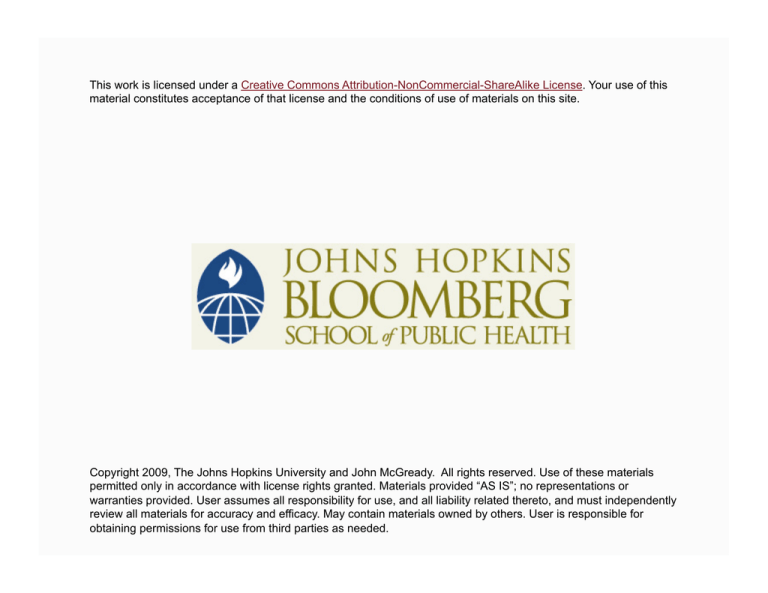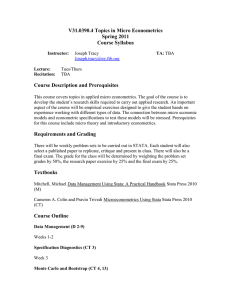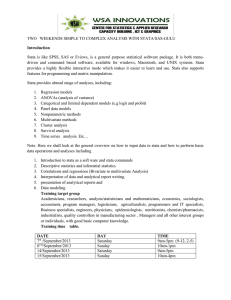
This work is licensed under a Creative Commons Attribution-NonCommercial-ShareAlike License. Your use of this
material constitutes acceptance of that license and the conditions of use of materials on this site.
Copyright 2009, The Johns Hopkins University and John McGready. All rights reserved. Use of these materials
permitted only in accordance with license rights granted. Materials provided “AS IS”; no representations or
warranties provided. User assumes all responsibility for use, and all liability related thereto, and must independently
review all materials for accuracy and efficacy. May contain materials owned by others. User is responsible for
obtaining permissions for use from third parties as needed.
Section B
Sample Size Calculations when Comparing Group Means
Example
Blood pressure and oral contraceptives
- Suppose we used data from the example in Section A to ask the
following question:
Is oral contraceptive use associated with higher blood
pressure among individuals between the ages of 35–39?
3
Pilot Study
Recall, the data:
Sample Data
n
Mean SBP
SD of SBP
OC users
8
132.8
15.3
Non-OC users
21
127.4
18.2
4
Pilot Study
We think this research has a potentially interesting association
We want to do a bigger study
- We want this larger study to have ample power to detect this
association, should it really exist in the population
What we want to do is determine sample sizes needed to detect
about a 5mm increase in blood pressure in O.C. users with 80%
power at significance level α = .05
- Using pilot data, we estimate that the standard deviations are
15.3 and 18.2 in O.C. and non-O.C. users respectively
5
Pilot Study
Here we have a desired power in mind and want to find the sample
sizes necessary to achieve a power of 80% to detect a population
difference in blood pressure of five or more mmHg between the two
groups
6
Pilot Study
We can find the necessary sample size(s) of this study if we specify
the following:
- α-level of test (.05)
- Specific values for µ1 and µ2 (specific HA) and hence d = µ1 - µ2:
this usually represents the minimum scientific difference of
interest
- Estimates of σ1 and σ2
- The desired power (.80)
7
Pilot Study
How can we specify d = µ1 - µ2 and estimate population SDs?
- Researcher knowledge—experience makes for good educated
guesses
- Make use of pilot study data!
8
Pilot Study
Fill in blanks from pilot study
- α -level of test (.05)
- Specific HA (µOC = 132.8, µNO OC = 127.4) and hence d = µ1 - µ2 =
5.4 mmHg
- Estimates of σOC (= 15.3) and σNO OC (= 18.2)
- The power we desire (.80)
9
Pilot Study
Given this information, we can use Stata to do the sample size
calculation
“sampsi” command
- Command syntax (items in italics are numbers to be supplied by
researcher)
- sampsi µ1 µ2, alpha(α) power(power) sd1(σ1) sd2(σ2)
10
Stata Results
Blood pressure/OC example
11
Pilot Study/Stata Results
Our results from Stata suggest that in order to detect a difference in
blood pressure of 5.4 units (if it really exists in the population) with
high (80%) certainty, we would need to enroll 153 OC users and 153
non-users
This assumes that we want equal numbers of women in each group!
12
Stata Results
Blood pressure/OC example
13
Pilot Study/Stata Results
Suppose we estimate that the prevalence of OC use amongst women
35–39 years of age is 20%
- We want this reflected in our group sizes
If OC users are 20% of the population, non-OC users are 80%
- There are four times as many non-users as there are users
(4:1 ratio)
14
Pilot Study/Stata Results
We can specify a ratio of group sizes in Stata
- Again, using “sampsi” command with “ratio” option
- sampsi µ1 µ2, alpha(α) power(power) sd1(σ1) sd2(σ2) ratio(n2/n1)
15
Stata Results
Blood pressure/OC example
16






